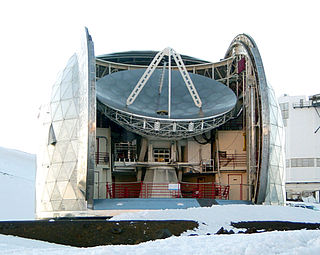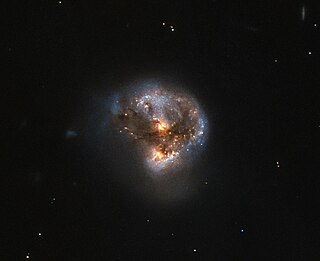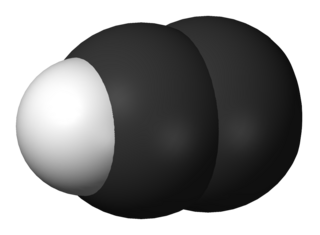
A molecular cloud, sometimes called a stellar nursery (if star formation is occurring within), is a type of interstellar cloud, the density and size of which permit absorption nebulae, the formation of molecules (most commonly molecular hydrogen, H2), and the formation of H II regions. This is in contrast to other areas of the interstellar medium that contain predominantly ionized gas.

Star formation is the process by which dense regions within molecular clouds in interstellar space, sometimes referred to as "stellar nurseries" or "star-forming regions", collapse and form stars. As a branch of astronomy, star formation includes the study of the interstellar medium (ISM) and giant molecular clouds (GMC) as precursors to the star formation process, and the study of protostars and young stellar objects as its immediate products. It is closely related to planet formation, another branch of astronomy. Star formation theory, as well as accounting for the formation of a single star, must also account for the statistics of binary stars and the initial mass function. Most stars do not form in isolation but as part of a group of stars referred as star clusters or stellar associations.

The interstellar medium (ISM) is the matter and radiation that exists in the space between the star systems in a galaxy. This matter includes gas in ionic, atomic, and molecular form, as well as dust and cosmic rays. It fills interstellar space and blends smoothly into the surrounding intergalactic space. The energy that occupies the same volume, in the form of electromagnetic radiation, is the interstellar radiation field. Although the density of atoms in the ISM is usually far below that in the best laboratory vacuums, the mean free path between collisions is short compared to typical interstellar lengths, so on these scales the ISM behaves as a gas, responding to pressure forces, and not as a collection of non-interacting particles.

The Sombrero Galaxy is a peculiar galaxy of unclear classification in the constellation borders of Virgo and Corvus, being about 9.55 megaparsecs from the Milky Way galaxy. It is a member of the Virgo II Groups, a series of galaxies and galaxy clusters strung out from the southern edge of the Virgo Supercluster. It has an isophotal diameter of approximately 29.09 to 32.32 kiloparsecs, making it slightly bigger in size than the Milky Way.

The Caltech Submillimeter Observatory (CSO) was a 10.4-meter (34 ft) diameter submillimeter wavelength telescope situated alongside the 15-meter (49 ft) James Clerk Maxwell Telescope (JCMT) at Mauna Kea Observatories. Beginning in 1986, it was engaged in submillimeter astronomy of the terahertz radiation band. The telescope closed on September 18, 2015.

The Submillimeter Array (SMA) consists of eight 6-meter (20 ft) diameter radio telescopes arranged as an interferometer for submillimeter wavelength observations. It is the first purpose-built submillimeter interferometer, constructed after successful interferometry experiments using the pre-existing 15-meter (49 ft) James Clerk Maxwell Telescope and 10.4-meter (34.1 ft) Caltech Submillimeter Observatory as an interferometer. All three of these observatories are located at Mauna Kea Observatory on Mauna Kea, Hawaii, and have been operated together as a ten element interferometer in the 230 and 345 GHz bands. The baseline lengths presently in use range from 16 to 508 meters. The radio frequencies accessible to this telescope range from 194–408 gigahertz (1.545–0.735 mm) which includes rotational transitions of dozens of molecular species as well as continuum emission from interstellar dust grains. Although the array is capable of operating both day and night, most of the observations take place at nighttime when the atmospheric phase stability is best.
Antarctic Submillimeter Telescope and Remote Observatory, or AST/RO, was a 1.7 meter diameter off-axis telescope for research in astronomy and aeronomy at wavelengths between 0.2 and 2 mm. The instrument operated between 1994 and 2005 at the South Pole with four heterodyne receivers and three acousto-optical spectrometers. It was replaced by the 10-m South Pole Telescope.

An astrophysical maser is a naturally occurring source of stimulated spectral line emission, typically in the microwave portion of the electromagnetic spectrum. This emission may arise in molecular clouds, comets, planetary atmospheres, stellar atmospheres, or various other conditions in interstellar space.

A megamaser is a type of astrophysical maser, which is a naturally occurring source of stimulated spectral line emission. Megamasers are distinguished from other astrophysical masers by their large isotropic luminosity. Megamasers have typical luminosities of 103 solar luminosities (L☉), which is 100 million times brighter than masers in the Milky Way, hence the prefix mega. Likewise, the term kilomaser is used to describe masers outside the Milky Way that have luminosities of order L☉, or thousands of times stronger than the average maser in the Milky Way, gigamaser is used to describe masers billions of times stronger than the average maser in the Milky Way, and extragalactic maser encompasses all masers found outside the Milky Way. Most known extragalactic masers are megamasers, and the majority of megamasers are hydroxyl (OH) megamasers, meaning the spectral line being amplified is one due to a transition in the hydroxyl molecule. There are known megamasers for three other molecules: water (H2O), formaldehyde (H2CO), and methine (CH).

IC 443 is a galactic supernova remnant (SNR) in the constellation Gemini. On the plane of the sky, it is located near the star Eta Geminorum. Its distance is roughly 5,000 light years from Earth.

The ethynyl radical (systematically named λ3-ethyne and hydridodicarbon(C—C)) is an organic compound with the chemical formula C≡CH (also written [CCH] or C
2H). It is a simple molecule that does not occur naturally on Earth but is abundant in the interstellar medium. It was first observed by electron spin resonance isolated in a solid argon matrix at liquid helium temperatures in 1963 by Cochran and coworkers at the Johns Hopkins Applied Physics Laboratory. It was first observed in the gas phase by Tucker and coworkers in November 1973 toward the Orion Nebula, using the NRAO 11-meter radio telescope. It has since been detected in a large variety of interstellar environments, including dense molecular clouds, bok globules, star forming regions, the shells around carbon-rich evolved stars, and even in other galaxies.

Submillimeter Wave Astronomy Satellite is a NASA submillimetre astronomy satellite, and is the fourth spacecraft in the Small Explorer program (SMEX). It was launched on 6 December 1998, at 00:57:54 UTC, from Vandenberg Air Force Base aboard a Pegasus XL launch vehicle. The telescope was designed by the Smithsonian Astrophysical Observatory (SAO) and integrated by Ball Aerospace, while the spacecraft was built by NASA's Goddard Space Flight Center (GSFC). The mission's principal investigator is Gary J. Melnick.
Sagittarius B2 is a giant molecular cloud of gas and dust that is located about 120 parsecs (390 ly) from the center of the Milky Way. This complex is the largest molecular cloud in the vicinity of the core and one of the largest in the galaxy, spanning a region about 45 parsecs (150 ly) across. The total mass of Sgr B2 is about 3 million times the mass of the Sun. The mean hydrogen density within the cloud is 3000 atoms per cm3, which is about 20–40 times denser than a typical molecular cloud.
Propynylidyne is a chemical compound that has been identified in interstellar space.
The X-factor in astrophysics, often labeled XCO, is an empirically determined proportionality constant which converts carbon monoxide (CO) emission line brightness to molecular hydrogen (H2) mass.
Patrick Thaddeus was an American professor and finished his career as the Robert Wheeler Willson Professor of Applied Astronomy Emeritus at Harvard University. He is best known for mapping carbon monoxide in the Milky Way galaxy and was responsible for the construction of the CfA 1.2 m Millimeter-Wave Telescope.
Thomas M. Dame is Director of the Radio Telescope Data Center at the Center for Astrophysics | Harvard & Smithsonian, a Senior Radio Astronomer at the Smithsonian Astrophysical Observatory, and a Lecturer on Astronomy at Harvard University. He is best known for mapping the Milky Way galaxy in Carbon Monoxide and for the discovery of both the Far 3 kpc Arm and the Outer Scutum–Centaurus Arm of the Milky Way.

ASW0009io9 (9io9) is a gravitationally lensed system of two galaxies. The nearer galaxy is approximately 2 billion light-years (610 Mpc) from Earth and is designated SDSS J020941.27+001558.4, while the lensed galaxy is 10 billion light-years (3.1 Gpc) distant and is designated ASW0009io9. It was discovered in January 2014 by a group of citizen scientists, while classifying images on the website Spacewarps.org. The discovery was announced on the BBC television programme Stargazing Live.
CO-0.40-0.22 is a high velocity compact gas cloud near the centre of the Milky Way. It is 200 light years away from the centre in the central molecular zone. The cloud is in the shape of ellipse. The differences in the velocity, termed velocity dispersion, of the gas is unusually high at 100 km/s.

NGC 4636 is an elliptical galaxy located in the constellation Virgo. It is a member of the NGC 4753 Group of galaxies, which is a member of the Virgo II Groups, a series of galaxies and galaxy clusters strung out from the southern edge of the Virgo Supercluster. It is located at a distance of about 55 million light years from Earth, which, given its apparent dimensions, means that NGC 4636 is about 105,000 light years across.















